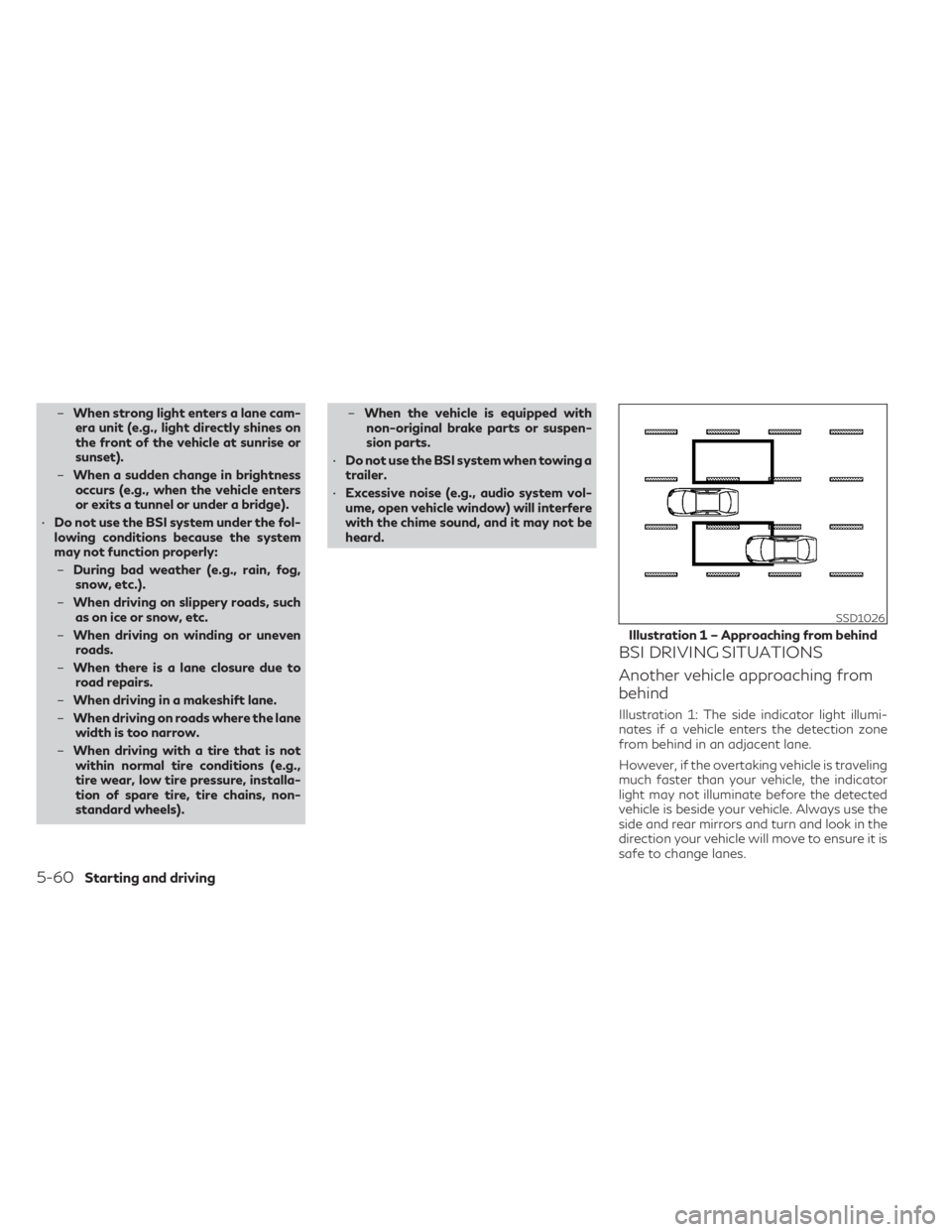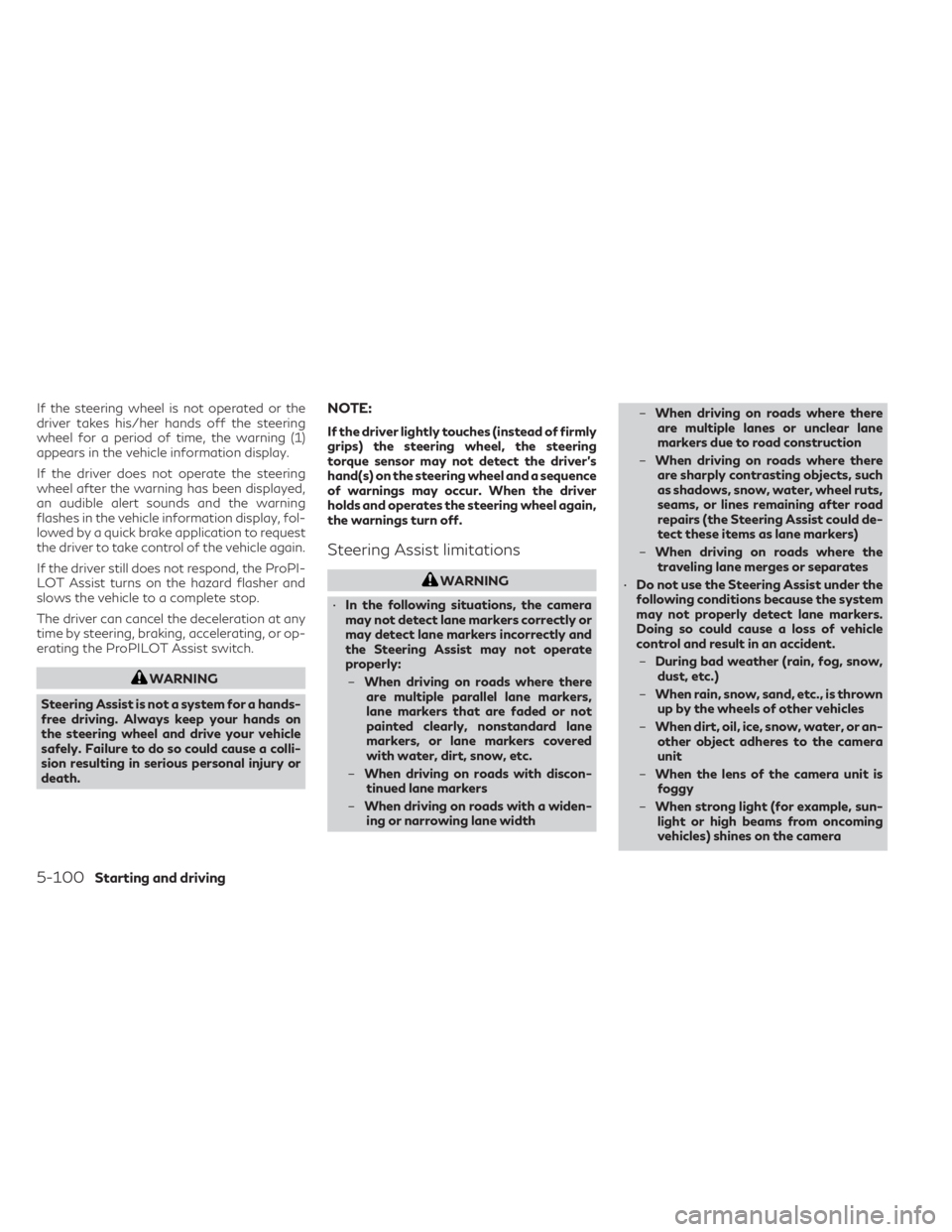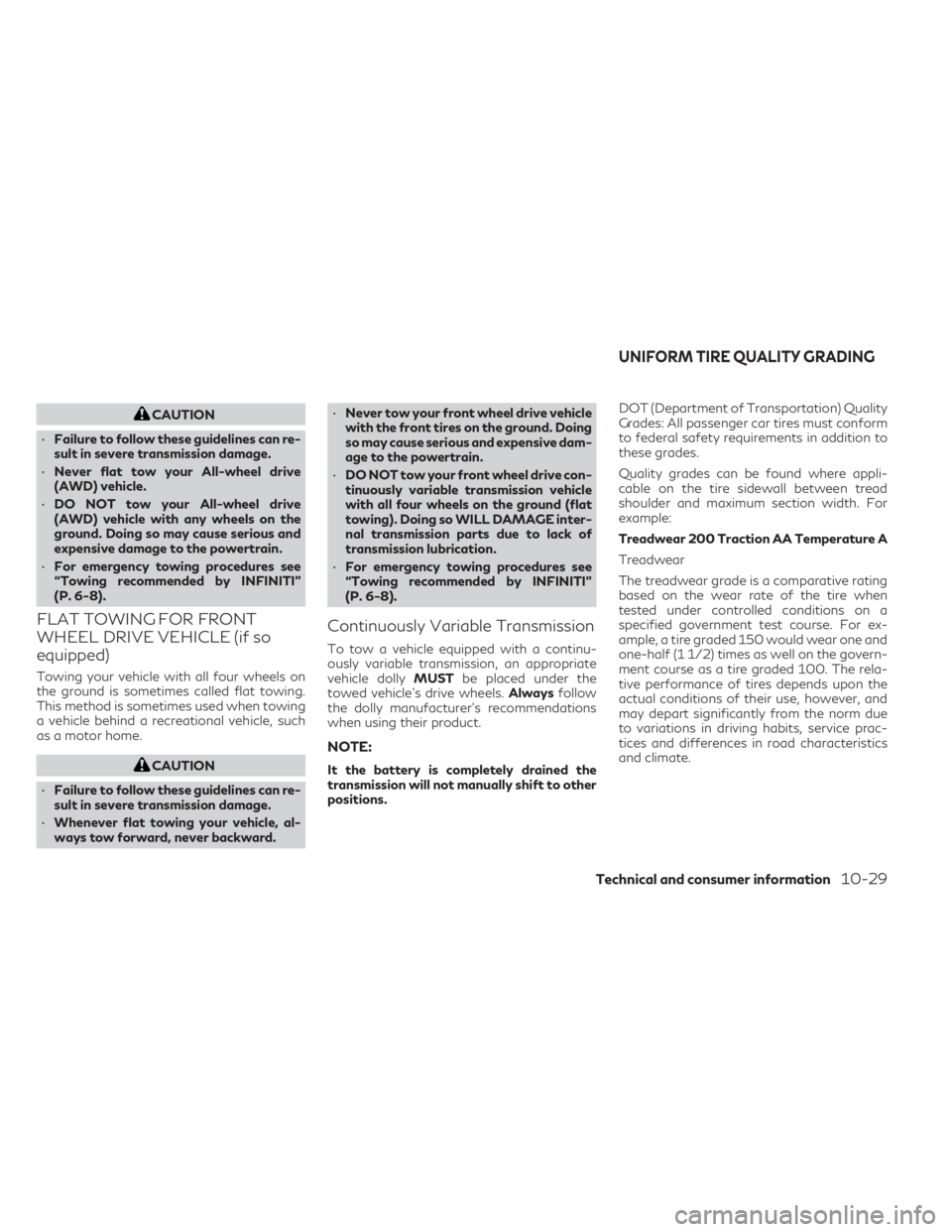width INFINITI QX50 2021 User Guide
[x] Cancel search | Manufacturer: INFINITI, Model Year: 2021, Model line: QX50, Model: INFINITI QX50 2021Pages: 542, PDF Size: 3.51 MB
Page 291 of 542

BSW SYSTEM LIMITATIONS
WARNING
Listed below are the system limitations for
the BSW system. Failure to operate the
vehicle in accordance with these system
limitations could result in serious injury or
death.
• The BSW system cannot detect all ve-
hicles under all conditions.
• The radar sensors may not be able to de-
tect and activate BSW when certain ob-
jects are present such as:
– Pedestrian, bicycles, animals.
– Vehicles such as motorcycles, low
height vehicles, or high ground clear-
ance vehicles.
– Oncoming vehicles.
– Vehicles remaining in the detection
zone when you accelerate from a
stop.
– A vehicle merging into an adjacent
lane at a speed approximately the
same as your vehicle.
– A vehicle approaching rapidly from
behind.
– A vehicle which your vehicle over-
takes rapidly. –
A vehicle that passes through the de-
tection zone quickly.
– When overtaking several vehicles in a
row, the vehicles after the first ve-
hicle may not be detected if they are
traveling close together.
• The radar sensors’ detection zone is de-
signed based on a standard lane width.
When driving in a wider lane, the radar
sensors may not detect vehicles in an ad-
jacent lane. When driving in a narrow
lane, the radar sensors may detect ve-
hicles driving two lanes away.
• The radar sensors are designed to ignore
most stationary objects; however, ob-
jects such as guardrails, walls, foliage
and parked vehicles may occasionally be
detected. This is a normal operation
condition.
• The following conditions may reduce the
ability of the radar to detect other ve-
hicles:
– Severe weather
– Road spray
– Ice/frost/snow/dirt build-up on the
vehicle •
Do not attach stickers (including trans-
parent material), install accessories or
apply additional paint near the radar
sensors. These conditions may reduce
the ability of the radar to detect other
vehicles.
• Excessive noise (for example, audio sys-
tem volume, open vehicle window) will
interfere with the chime sound, and it
may not be heard.
Starting and driving5-49
Page 301 of 542

–Oncoming vehicles.
– Vehicles remaining in the detection
zone when you accelerate from a
stop. For additional information, see
“BSI driving situations” (P. 5-60).
– A vehicle merging into an adjacent
lane at a speed approximately the
same as your vehicle. For additional
information, see “BSI driving situa-
tions” (P. 5-60).
– A vehicle approaching rapidly from
behind. For additional information,
see “BSI driving situations” (P. 5-60).
– A vehicle which your vehicle over-
takes rapidly. For additional infor-
mation, see “BSI driving situations”
(P. 5-60).
– A vehicle that passes through the de-
tection zone quickly.
– When overtaking several vehicles in a
row, the vehicles after the first ve-
hicle may not be detected if they are
traveling close together. •
The radar sensors’ detection zone is de-
signed based on a standard lane width.
When driving in a wider lane, the radar
sensors may not detect vehicles in an ad-
jacent lane. When driving in a narrow
lane, the radar sensors may detect ve-
hicles driving two lanes away.
• The radar sensors are designed to ignore
most stationary objects; however, ob-
jects such as guardrails, walls, foliage
and parked vehicles may occasionally be
detected. This is a normal driving
condition.
• The following conditions may reduce the
ability of the radar to detect other ve-
hicles:
– Severe weather
– Road spray
– Ice/frost/dirt build-up on the vehicle
• Do not attach stickers (including trans-
parent material), install accessories or
apply additional paint near the radar
sensors. These conditions may reduce
the ability of the radar to detect other
vehicles.
• The camera may not detect lane markers
in the following situations and the BSI
system may not operate properly: –
On roads where there are multiple
parallel lane markers; lane markers
that are faded or not painted clearly;
yellow painted lane markers; non-
standard lane markers; lane markers
covered with water, dirt, snow, etc.
– On roads where discontinued lane
markers are still detectable.
– On roads where there are sharp
curves.
– On roads where there are sharply
contrasting objects, such as shad-
ows, snow, water, wheel ruts, seams
or lines remaining after road repairs.
– On roads where the traveling lane
merges or separates.
– When the vehicle’s traveling direction
does not align with the lane markers.
– When traveling close to the vehicle in
front of you, which obstructs the lane
camera unit detection range.
– When rain, snow or dirt adheres to
the windshield in front of a lane cam-
era unit.
– When the headlights are not bright
due to dirt on the lens or if aiming is
not adjusted properly.
Starting and driving5-59
Page 302 of 542

–When strong light enters a lane cam-
era unit (e.g., light directly shines on
the front of the vehicle at sunrise or
sunset).
– When a sudden change in brightness
occurs (e.g., when the vehicle enters
or exits a tunnel or under a bridge).
• Do not use the BSI system under the fol-
lowing conditions because the system
may not function properly:
– During bad weather (e.g., rain, fog,
snow, etc.).
– When driving on slippery roads, such
as on ice or snow, etc.
– When driving on winding or uneven
roads.
– When there is a lane closure due to
road repairs.
– When driving in a makeshift lane.
– When driving on roads where the lane
width is too narrow.
– When driving with a tire that is not
within normal tire conditions (e.g.,
tire wear, low tire pressure, installa-
tion of spare tire, tire chains, non-
standard wheels). –
When the vehicle is equipped with
non-original brake parts or suspen-
sion parts.
• Do not use the BSI system when towing a
trailer.
• Excessive noise (e.g., audio system vol-
ume, open vehicle window) will interfere
with the chime sound, and it may not be
heard.
BSI DRIVING SITUATIONS
Another vehicle approaching from
behind
Illustration 1: The side indicator light illumi-
nates if a vehicle enters the detection zone
from behind in an adjacent lane.
However, if the overtaking vehicle is traveling
much faster than your vehicle, the indicator
light may not illuminate before the detected
vehicle is beside your vehicle. Always use the
side and rear mirrors and turn and look in the
direction your vehicle will move to ensure it is
safe to change lanes.
SSD1026
Illustration 1 – Approaching from behind
5-60Starting and driving
Page 342 of 542

If the steering wheel is not operated or the
driver takes his/her hands off the steering
wheel for a period of time, the warning (1)
appears in the vehicle information display.
If the driver does not operate the steering
wheel after the warning has been displayed,
an audible alert sounds and the warning
flashes in the vehicle information display, fol-
lowed by a quick brake application to request
the driver to take control of the vehicle again.
If the driver still does not respond, the ProPI-
LOT Assist turns on the hazard flasher and
slows the vehicle to a complete stop.
The driver can cancel the deceleration at any
time by steering, braking, accelerating, or op-
erating the ProPILOT Assist switch.
WARNING
Steering Assist is not a system for a hands-
free driving. Always keep your hands on
the steering wheel and drive your vehicle
safely. Failure to do so could cause a colli-
sion resulting in serious personal injury or
death.
NOTE:
If the driver lightly touches (instead of firmly
grips) the steering wheel, the steering
torque sensor may not detect the driver’s
hand(s) on the steering wheel and a sequence
of warnings may occur. When the driver
holds and operates the steering wheel again,
the warnings turn off.
Steering Assist limitations
WARNING
• In the following situations, the camera
may not detect lane markers correctly or
may detect lane markers incorrectly and
the Steering Assist may not operate
properly:
– When driving on roads where there
are multiple parallel lane markers,
lane markers that are faded or not
painted clearly, nonstandard lane
markers, or lane markers covered
with water, dirt, snow, etc.
– When driving on roads with discon-
tinued lane markers
– When driving on roads with a widen-
ing or narrowing lane width –
When driving on roads where there
are multiple lanes or unclear lane
markers due to road construction
– When driving on roads where there
are sharply contrasting objects, such
as shadows, snow, water, wheel ruts,
seams, or lines remaining after road
repairs (the Steering Assist could de-
tect these items as lane markers)
– When driving on roads where the
traveling lane merges or separates
• Do not use the Steering Assist under the
following conditions because the system
may not properly detect lane markers.
Doing so could cause a loss of vehicle
control and result in an accident.
– During bad weather (rain, fog, snow,
dust, etc.)
– When rain, snow, sand, etc., is thrown
up by the wheels of other vehicles
– When dirt, oil, ice, snow, water, or an-
other object adheres to the camera
unit
– When the lens of the camera unit is
foggy
– When strong light (for example, sun-
light or high beams from oncoming
vehicles) shines on the camera
5-100Starting and driving
Page 461 of 542

O1Tire size (example: P215/65R15
95H)
1. P: The “P” indicates the tire is de- signed for passenger vehicles (not
all tires have this information).
2. Three-digit number (215): This number gives the width in millime-
ters of the tire from sidewall edge
to sidewall edge. 3. Two-digit number (65): This num-
ber, known as the aspect ratio,
gives the tire's ratio of height to
width.
4. R: The “R” stands for radial.
5. Two-digit number (15): This num- ber is the wheel or rim diameter in
inches. 6. Two- or three-digit number (95):
This number is the tire's load index.
It is a measurement of how much
weight each tire can support. You
may not find this information on all
tires because it is not required by
law.
7. H: Tire speed rating. You should not drive the vehicle faster than the tire
speed rating.
WDI0395
Example
Do-it-yourself8-31
Page 505 of 542

WHEELS AND TIRES
Wheel typeOffset in (mm) Size
Aluminum 1.54 (39)19 x 7.5J
1.73 (44) 20 x 8.5J
Tire size P235/55RF19
P255/45RF20
Spare tire Not equipped
DIMENSIONS AND WEIGHTS
Overall lengthin (mm) 184.8 (4,693)
Overall width in (mm) 74.9 (1,903)
Overall height in (mm) 66.1 (1,679)
Front track 19 inch wheel in (mm) 64.4 (1,635)
20 inch wheel in (mm) 64.0 (1,625)
Rear track 19 inch wheel in (mm) 64.2 (1,630)
20 inch wheel in (mm) 63.8 (1,620)
Wheelbase in (mm) 110.2 (2,800)
Gross vehicle weight rating lbs. (kg) Refer to the “F.M.V.S.S./
C.M.V.S.S. certifica-
tion label” on the
center pillar be-
tween the driver's
side front and rear
doors.
Gross axle weight rating
Front lbs. (kg)
Rear lbs. (kg)
Technical and consumer information10-9
Page 525 of 542

CAUTION
• Failure to follow these guidelines can re-
sult in severe transmission damage.
• Never flat tow your All-wheel drive
(AWD) vehicle.
• DO NOT tow your All-wheel drive
(AWD) vehicle with any wheels on the
ground. Doing so may cause serious and
expensive damage to the powertrain.
• For emergency towing procedures see
“Towing recommended by INFINITI”
(P. 6-8).
FLAT TOWING FOR FRONT
WHEEL DRIVE VEHICLE (if so
equipped)
Towing your vehicle with all four wheels on
the ground is sometimes called flat towing.
This method is sometimes used when towing
a vehicle behind a recreational vehicle, such
as a motor home.
CAUTION
• Failure to follow these guidelines can re-
sult in severe transmission damage.
• Whenever flat towing your vehicle, al-
ways tow forward, never backward. •
Never tow your front wheel drive vehicle
with the front tires on the ground. Doing
so may cause serious and expensive dam-
age to the powertrain.
• DO NOT tow your front wheel drive con-
tinuously variable transmission vehicle
with all four wheels on the ground (flat
towing). Doing so WILL DAMAGE inter-
nal transmission parts due to lack of
transmission lubrication.
• For emergency towing procedures see
“Towing recommended by INFINITI”
(P. 6-8).
Continuously Variable Transmission
To tow a vehicle equipped with a continu-
ously variable transmission, an appropriate
vehicle dolly MUSTbe placed under the
towed vehicle's drive wheels. Alwaysfollow
the dolly manufacturer's recommendations
when using their product.
NOTE:
It the battery is completely drained the
transmission will not manually shift to other
positions. DOT (Department of Transportation) Quality
Grades: All passenger car tires must conform
to federal safety requirements in addition to
these grades.
Quality grades can be found where appli-
cable on the tire sidewall between tread
shoulder and maximum section width. For
example:
Treadwear 200 Traction AA Temperature A
Treadwear
The treadwear grade is a comparative rating
based on the wear rate of the tire when
tested under controlled conditions on a
specified government test course. For ex-
ample, a tire graded 150 would wear one and
one-half (1 1/2) times as well on the govern-
ment course as a tire graded 100. The rela-
tive performance of tires depends upon the
actual conditions of their use, however, and
may depart significantly from the norm due
to variations in driving habits, service prac-
tices and differences in road characteristics
and climate.
UNIFORM TIRE QUALITY GRADING
Technical and consumer information10-29